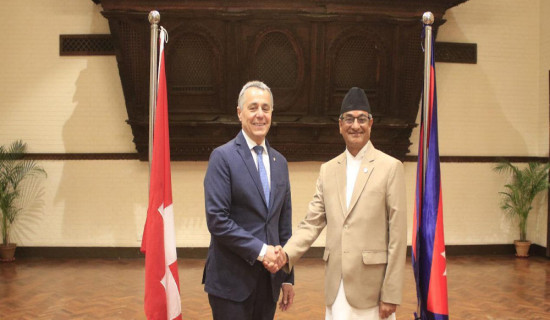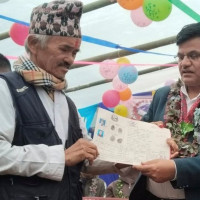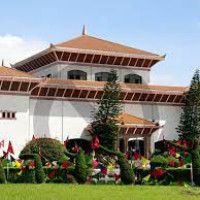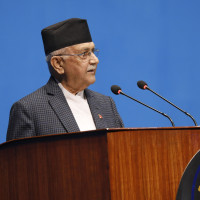- Monday, 7 July 2025
Innovation Centre struggles to bring agro tools plant back to operation
By Nayak Paudel,Birgunj, Jun1: “You did not have to ask for the location before as the sound of the machines operating inside the factory could be heard here itself,” a pedestrian in his 60s responded when asked the location of the Krishi Aujar Karkhana along the Pathlaiya-Birgunj Highway.
Krishi Aujar Karkhana (KAK), an agricultural tools manufacturing factory, was one of a handful of government industries until the 1990s. Inaugurated by King Mahendra Shah, the factory was established with the support of the then Union of Soviet Socialist Republics (USSR) in 1967.
Nepal’s economy has been largely dependent on agriculture for centuries. The establishment of the KAK was also a result of the demand for advanced technologies and tools to make farming easier. Over the years, agriculture production has been increasing. However, its significance has decreased.
“Despite its growth, the significance of the agricultural sector in the national economy has been diminishing over the years. The share of agriculture in the GDP was 66.9 per cent in 1970, but it kept continued to decline and dropped to 25 per cent in 2018,” read the National Economic Census 2018 published in March 2021.
Experts argue that the interest of the government as well as the public in the agriculture sector declined over the years leading to the shutdown of the KAK.
The KAK, which produced agricultural tools, such as shovels, spades, ploughs and sickles, was said to have operated profitably in its starting years.
However, the step of privatising the KAK in 1997, after the factory was shut in 1995 citing lack of capital, with an aim to upgrade and make it more profitable backfired. It was in 2003 when the KAK was shut down for good.
Now, two decades later, the government, in September 2022, decided to reopen the factory by handing it over to the Mahabir Pun-led National Innovation Centre (NIC).
Reopened but neglected
On September 27, 2022, the Ministry of Finance signed an agreement with the NIC to allow the latter to operate the KAK for the next 10 years.
According to the agreement, the government would invest the initial cost required to bring the factory into full operation. After that, the NIC will operate the factory, manufacture the required tools and sell them.
For the next 10 years, the NIC will keep 50 per cent of the profit and the rest will be provided to the Inland Revenue Department.
The NIC had requested for around Rs. 150 to 200 million to bring the factory into operation and the government had assured the support.
Talking to The Rising Nepal on Wednesday, Mahabir Pun said, “I have just walked out from a room of the Finance Ministry. I am visiting the ministry requesting for only Rs. 10 million of the assured support for the KAK.”
Mechanical engineers of the NIC working at the KAK informed that
they could bring the factory into full operation within a year if they received adequate economic support.
“A forest had grown not only on the outer premises of the KAK but also inside the factories where machines were kept. It took us several days to clean the area with the support of locals. We could bring many machines into operation at the first try,” said Prajal Koju, a mechanical engineer associated with the NIC who is overseeing the KAK.
At least half-a-dozen engineers and technicians can be sighted at the dilapidated KAK factory working on different machines. “It took us 22 days to bring a die-cutting machine into operation. We sought several former employees of the factory for assistance,” said Koju.
Pun, in a Facebook post on Tuesday, informed that a cupola furnace, a large machine used to melt iron, was also repaired at the KAK after working on it for three weeks.
“We were in awe when we saw the machinery for the first time. It is because the factory is large, advanced and full of prospects. If we can bring all the old machines into operation and add some advanced technology, we can operate the KAK in a way that it manufactures all required agricultural tools,” said Koju.
Plans for the KAK
The NIC representatives informed that they only have 10 years to implement their plans. The technicians are currently busy repairing machinery and producing agriculture tools from the repaired machines.
“We have started manufacturing basic tools like shovels and spades. In the future, we have plans to manufacture de-watering machines for manure, rice planters, hand tractors and fibre extraction machines for textile industries, among others,” said Koju.
Similarly, the NIC also plans to establish an idea incubation centre in Birgunj where aspirants can come up with new ideas and innovations in the agriculture sector.
“If the KAK could be operated effectively, we can increase public participation in agriculture with motivation through Nepal-made advanced agriculture tools,” said Pun.
Major challenges
The major challenge that the KAK is facing is a lack of enough economic support. “The NIC has already spent over Rs. 4.5 million in the revival of the KAK,” said Koju.
The NIC has been covering the cost of bringing the old machines of the KAK into operation and the wages and logistics for the engineers and technicians deployed there on its own.
In lack of the necessary budget, Pun had earlier declared to sell his personal lands. However, with a request from his well-wishers, Pun is currently busy on his biography.
“By selling the biography, I will collect the money for the KAK’s operation. I will not wait for others because I have limited time to restore this historical and important factory,” said Pun.
On the other hand, Koju informed that the factory would not be profitable if the import of agricultural tools from foreign countries continued.
“For instance, a shovel manufactured in the KAK would cost Rs. 350 excluding labour charges. However, a similar shovel imported from India or China would cost less than Rs. 350. There is a need to promote and motivate local products by increasing government investment,” said Koju.
The KAK also does not have a proper electricity supply as the factory has still not paid around Rs. 7 million to the Nepal Electricity Authority (NEA).
“A separate 65-KVA electric supply has been brought to the factory under the name of the NIC. This electric supply is not enough to operate the factory in its full capacity,” said Koju.








copy-square-thumb.jpg)







